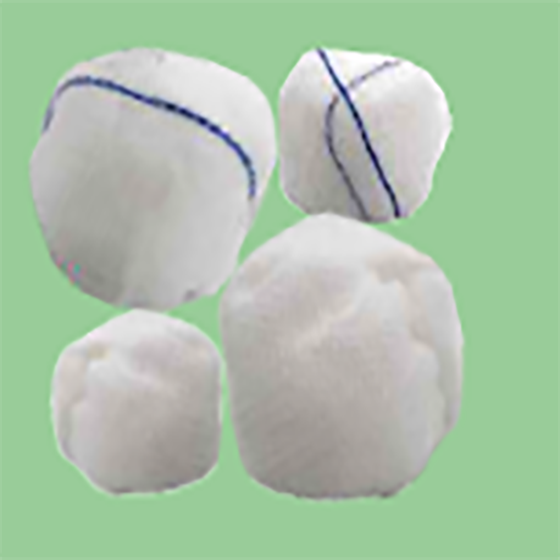NEWS CENTER
The Essential Role of Gauze Balls in Wound Care: A Comprehensive Guide
Release time:
2025-04-25
1. Introduction to Wound Care and Healing
In the healthcare sector, effective wound care is paramount for facilitating proper healing and preventing complications. Wounds, whether acute or chronic, require appropriate management to ensure that they heal effectively and efficiently. Among various wound care supplies, **gauze balls** play a crucial role in the treatment and management of wounds. These small, absorbent materials are often overlooked yet serve multiple essential functions in wound care. This article explores the various aspects of gauze balls, their significance, and how they contribute to optimal wound care practices.

2. Understanding Gauze Balls: What Are They?
Gauze balls are soft, absorbent balls made from woven or non-woven fabric, typically cotton or a cotton blend. They are designed to absorb exudate, control bleeding, and protect wounds from contamination. Their structure allows for excellent fluid retention, making them an ideal choice for various medical and surgical applications.
Unlike traditional gauze pads, gauze balls are smaller and more versatile, allowing healthcare professionals to apply them effectively in different wound scenarios. Their use extends beyond simple wound dressing; gauze balls can be instrumental in surgical procedures, first aid, and even during post-operative care.
3. The Advantages of Using Gauze Balls in Wound Management
Gauze balls provide numerous benefits that make them a staple in wound care. Here are some of the most significant advantages:
3.1. Absorbency and Fluid Control
One of the primary functions of gauze balls is to absorb excess fluid from wounds. This absorbency is crucial for preventing maceration of surrounding skin and ensuring a conducive environment for healing. By effectively controlling the moisture levels, gauze balls help maintain a balance that promotes tissue regeneration.
3.2. Promoting a Clean Healing Environment
Gauze balls act as barriers against external contaminants. By covering wounds with sterile gauze balls, healthcare providers can protect the wound from bacteria and other harmful pathogens, significantly reducing the risk of infection. Their ability to create a clean environment is particularly vital in post-operative care, where surgical sites are susceptible to complications.
3.3. Versatility in Application
The design of gauze balls allows for their use in various settings—from emergency response to follow-up care. They can be employed for direct pressure application to control bleeding, as packing material in deeper wounds, or as part of a dressing regime for chronic wounds. Their versatility makes them an invaluable tool for healthcare practitioners.
4. Different Types of Gauze Balls: Which One to Choose?
Not all gauze balls are created equal. Understanding the different types available can help healthcare professionals make informed choices based on the specific needs of the wound.
4.1. Sterile vs. Non-Sterile Gauze Balls
Sterile gauze balls are specifically processed to eliminate any microbial life, making them ideal for acute wounds and surgical applications. In contrast, non-sterile gauze balls may be used for less critical applications, such as cleaning or dressing non-infected wounds. Choosing the right type is essential to prevent infections and promote healing.
4.2. Materials Used in Gauze Balls
Gauze balls can be made from various materials, including cotton, rayon, and blends. Cotton gauze is highly absorbent and soft, making it a preferred option for most applications. However, rayon-based gauze balls may offer enhanced fluid retention capabilities, which can be beneficial in specific cases.
5. Proper Techniques for Using Gauze Balls
To maximize the effectiveness of gauze balls in wound care, proper techniques must be followed. Here are some guidelines:
5.1. Preparing the Wound Site
Before applying gauze balls, it is crucial to clean the wound site properly. Use an appropriate antiseptic solution to clean the area, ensuring that any debris or contaminants are removed. This step is vital for reducing the risk of infection.
5.2. Application and Dressing Changes
Gauze balls should be applied gently to the wound, ensuring they cover the affected area adequately. Depending on the amount of exudate, dressing changes may be necessary. It is essential to monitor the wound regularly, replacing gauze balls when saturated to maintain optimal healing conditions.
6. Common Mistakes to Avoid When Using Gauze Balls
While gauze balls are relatively straightforward to use, certain mistakes can hinder their effectiveness. Here are common pitfalls to avoid:
- **Using Non-Sterile Gauze on Open Wounds:** Always opt for sterile gauze balls for open or surgical wounds to prevent infections.
- **Neglecting Regular Dressing Changes:** Failing to change gauze balls promptly can lead to increased risk of infection and delayed healing.
- **Applying Too Much Pressure:** While gauze balls should apply some pressure to control bleeding, excessive pressure can impede blood flow and hinder healing.
In the realm of wound care, gauze balls are indispensable tools that support healing and reduce the risk of complications. Their absorbent properties, versatility, and protective capabilities make them a focal point in effective wound management. By understanding their role and employing them correctly, healthcare professionals and caregivers can enhance patient outcomes significantly. As wound care continues to evolve, gauze balls will remain a foundational component in delivering quality healthcare.

Company headquarters
Factory address: YuanGuang Road, Qianjiang, Hubei, China
Tel:+86 728-6480 913
Fax:+86 728-6480 939
EMail:admin@qjmdmgauze.com

Sales Department
Deputy General Manager: Pascal
Tel: 027 85759366
Mob: 136 6725 4953
Email:admin@qjmdmgauze.com





